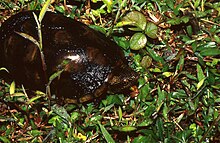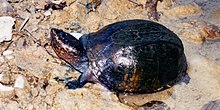Scorpion mud turtle: Difference between revisions
collapse syn list |
OhanaUnited (talk | contribs) m headings |
||
| (19 intermediate revisions by 12 users not shown) | |||
| Line 3: | Line 3: | ||
| name = Scorpion mud turtle |
| name = Scorpion mud turtle |
||
| image = Mud Turtle (Kinosternon scorpioides) (36602010632).jpg |
| image = Mud Turtle (Kinosternon scorpioides) (36602010632).jpg |
||
| image_caption = |
| image_caption = In Alajuela Province, Costa Rica |
||
| status = LR/lc |
| status = LR/lc |
||
| status_system = IUCN2.3 |
| status_system = IUCN2.3 |
||
| status_ref = |
|||
| status_ref = <ref name="iucn status 9 April 2022">{{cite iucn |author=Tortoise & Freshwater Turtle Specialist Group|date=1996 |title=Kinosternon acutum (errata version published in 2016) |volume=1996|page=e.T11010A97378920|doi=10.2305/IUCN.UK.1996.RLTS.T11010A3238234.en|access-date=9 April 2022}}</ref> |
|||
| genus = Kinosternon |
| genus = Kinosternon |
||
| species = scorpioides |
| species = scorpioides |
||
| Line 68: | Line 68: | ||
* ''Kinosternon scorpioides serei'' <small>Iverson, 1986</small> (''ex errore'') |
* ''Kinosternon scorpioides serei'' <small>Iverson, 1986</small> (''ex errore'') |
||
* ''Kinosternon scorpioides serieli'' <small>Gosławski & Hryniewicz, 1993</small> (''ex errore'') |
* ''Kinosternon scorpioides serieli'' <small>Gosławski & Hryniewicz, 1993</small> (''ex errore'') |
||
* ''Kinosternon scorpioides carajanensis'' <small>Rogner, 1996</small> (''ex errore'') |
* ''Kinosternon scorpioides carajanensis'' <small>Rogner, 1996</small> (''ex errore'') |
||
(''K. s. |
(''K. s. albogulare)'' |
||
* ''Kinosternon abaxillare'' <small>Baur, 1925</small> |
|||
* ''Kinosternon scorpioides abaxillare'' <small>Berry, 1979</small> |
|||
* ''Kinosternon cruentatum abaxillare'' <small>Artner, 2003</small> |
|||
* ''Kinosternon scorpioides carajasense'' <small>Joseph-Ouni, 2004</small> (''ex errore'')<br> |
|||
(''K. s. albogulare)''<br> |
|||
* ''Cinosternon albogulare'' <small>Duméril & Bocourt, 1870</small> |
* ''Cinosternon albogulare'' <small>Duméril & Bocourt, 1870</small> |
||
* ''Cinosternum albogulare'' <small>Cope, 1875</small> |
* ''Cinosternum albogulare'' <small>Cope, 1875</small> |
||
* ''Kinosternon cruentatum albogulare'' <small>Wettstein, 1934</small> |
* ''Kinosternon cruentatum albogulare'' <small>Wettstein, 1934</small> |
||
* ''Kinosternon scorpioides albogulare'' <small>Dunn & Saxe, 1950</small |
* ''Kinosternon scorpioides albogulare'' <small>Dunn & Saxe, 1950</small> |
||
(''K. s. cruentatum'') |
(''K. s. cruentatum'') |
||
* ''Cinosternon cruentatum'' <small>Duméril & Bibron, 1851</small> |
* ''Cinosternon cruentatum'' <small>Duméril & Bibron, 1851</small> |
||
| Line 100: | Line 95: | ||
* ''Kinosternon scorpioides cruentatum'' <small>Berry, 1979</small> |
* ''Kinosternon scorpioides cruentatum'' <small>Berry, 1979</small> |
||
* ''Kinosternon cruentatum consor'' <small>Obst, 1996</small> (''ex errore'') {{hidden end}} |
* ''Kinosternon cruentatum consor'' <small>Obst, 1996</small> (''ex errore'') {{hidden end}} |
||
| synonyms_ref = <ref name="Fritz 2007">{{Cite journal | journal = Vertebrate Zoology | title = Checklist of Chelonians of the World | year = 2007 | author = Fritz Uwe | author2 = Peter Havaš | volume = 57 | issue = 2 | pages = 255–258 | |
| synonyms_ref = <ref name="Fritz 2007">{{Cite journal | journal = Vertebrate Zoology | title = Checklist of Chelonians of the World | year = 2007 | author = Fritz Uwe | author2 = Peter Havaš | volume = 57 | issue = 2 | pages = 255–258 | doi = 10.3897/vz.57.e30895 | s2cid = 87809001 | issn = 1864-5755 | doi-access = free }}</ref> |
||
}} |
}} |
||
The '''scorpion mud turtle''' or '''Tabasco mud turtle''' ('''''Kinosternon scorpioides''''') is a species of [[mud turtle]] in the family [[Kinosternidae]]. It is found in Mexico, Central and South America. |
|||
The '''scorpion mud turtle''' (''Kinosternon scorpioides'') is a species of [[mud turtle]] in the family [[Kinosternidae]]. It is found in Mexico, Central and South America. It is a medium to large kinosternid (mud turtle) with a domed, oval upper shell 92–270 mm (3.6–10.6 in) long. Males regularly exceed 200 mm. The scorpion mud turtle is a highly aquatic, adaptable kinosternid that will live in almost any body of water. It is primarily omnicarnivorous, a glutton, and feeds on a wide variety of aquatic invertebrates (such as [[insect]]s and their larvae, [[spider]]s, [[shrimp]], [[crab]]s, [[snail]]s and [[worm]]s)<ref name="UWI">{{cite web|url=https://sta.uwi.edu/fst/lifesciences/sites/default/files/lifesciences/documents/ogatt/Kinosternon_scorpioides%20-%20Scorpion%20Mud%20Turtle.pdf|format=PDF|title=Kinosternon scorpioides (Scorpion Mud Turtle)|website=Sta.uwi.edu|access-date=9 April 2022}}</ref> and vertebrates (such as [[fish]] and [[frog]]s),<ref name="UWI" /> including carrion and bird eggshells.<ref name="UWI" /> It also feeds on plant material such as [[algae]], [[fruit]]s, [[Nut (fruit)|nut]]s, [[seed]]s and [[aquatic plants]].<ref name="UWI" /> In captivity, poorly fed ''K. scorpioides'' can be cannibalistic, biting off the toes and limbs of conspecifics. Females probably lay 1 to 6 hard-shelled eggs. Like many kinosternids, they probably construct a shallow terrestrial nest with little cover.<ref>{{cite web |title=''Kinosternon scorpiodes'' (Linnaeus, 1766) |url=https://nas.er.usgs.gov/queries/FactSheet.aspx?speciesID=1266 |publisher=U.S. Geological Survey, Department of the Interior |accessdate=November 10, 2018 |archiveurl=https://web.archive.org/web/20090509172524/https://nas.er.usgs.gov/queries/FactSheet.asp?speciesID=1266 |archivedate=May 9, 2009}} {{PD-notice}}</ref> |
|||
| ⚫ | |||
== Description == |
|||
The scorpion mud turtle is a medium to large kinosternid (mud turtle) with a domed, oval upper shell 92–270 mm (3.6–10.6 in) long. Males regularly exceed 200 mm. The scorpion mud turtle is a highly aquatic, adaptable kinosternid that will live in almost any body of water. |
|||
== Diet == |
|||
It is primarily omnicarnivorous, a glutton, and feeds on a wide variety of aquatic invertebrates (such as [[insect]]s and their larvae, [[spider]]s, [[shrimp]], [[crab]]s, [[snail]]s and [[worm]]s) and vertebrates (such as [[fish]] and [[frog]]s), as well as carrion and bird eggshells.<ref name="UWI">{{cite web|url=https://sta.uwi.edu/fst/lifesciences/sites/default/files/lifesciences/documents/ogatt/Kinosternon_scorpioides%20-%20Scorpion%20Mud%20Turtle.pdf|title=Kinosternon scorpioides (Scorpion Mud Turtle)|website=Sta.uwi.edu|access-date=9 April 2022}}</ref> It also feeds on plant material such as [[algae]], [[fruit]]s, [[flower]]s, [[Nut (fruit)|nut]]s, [[seed]]s and [[aquatic plants]].<ref name="UWI" /><ref>{{cite web | url=https://www.reptilesofecuador.com/kinosternon_scorpioides.html | title=Scorpion Mud Turtle (Kinosternon scorpioides) }}</ref> In captivity, poorly fed ''K. scorpioides'' can be cannibalistic, biting off the toes and limbs of conspecifics. |
|||
== Reproduction and habitat == |
|||
Females probably lay 1 to 6 hard-shelled eggs. Like many kinosternids, they probably construct a shallow terrestrial nest with little cover.<ref>{{cite web |title=''Kinosternon scorpiodes'' (Linnaeus, 1766) |url=https://nas.er.usgs.gov/queries/FactSheet.aspx?speciesID=1266 |publisher=U.S. Geological Survey, Department of the Interior |accessdate=November 10, 2018 |archiveurl=https://web.archive.org/web/20090509172524/https://nas.er.usgs.gov/queries/FactSheet.asp?speciesID=1266 |archivedate=May 9, 2009}} {{PD-notice}}</ref> |
|||
| ⚫ | |||
== Subspecies == |
== Subspecies == |
||
| Line 110: | Line 114: | ||
*[[White-throated mud turtle]] – ''Kinosternon scorpioides albogulare'' (Duméril and Bibron, 1870) |
*[[White-throated mud turtle]] – ''Kinosternon scorpioides albogulare'' (Duméril and Bibron, 1870) |
||
*[[Red-cheeked mud turtle]] – ''Kinosternon scorpioides cruentatum'' ([[Auguste Duméril|Duméril]], [[Gabriel Bibron|Bibron]] & [[André Marie Constant Duméril|Duméril]], 1851) |
*[[Red-cheeked mud turtle]] – ''Kinosternon scorpioides cruentatum'' ([[Auguste Duméril|Duméril]], [[Gabriel Bibron|Bibron]] & [[André Marie Constant Duméril|Duméril]], 1851) |
||
==References== |
==References== |
||
| Line 131: | Line 130: | ||
[[Category:Turtles of North America]] |
[[Category:Turtles of North America]] |
||
[[Category:Turtles of South America]] |
[[Category:Turtles of South America]] |
||
[[Category: |
[[Category:Turtles of Brazil]] |
||
[[Category:Reptiles of |
[[Category:Reptiles of Mexico]] |
||
[[Category:Reptiles of Central America]] |
|||
[[Category:Taxa named by Carl Linnaeus]] |
[[Category:Taxa named by Carl Linnaeus]] |
||
[[Category:Reptiles described in 1766]] |
[[Category:Reptiles described in 1766]] |
||
Latest revision as of 05:17, 24 April 2024
| Scorpion mud turtle | |
|---|---|

| |
| In Alajuela Province, Costa Rica | |
| Scientific classification | |
| Domain: | Eukaryota |
| Kingdom: | Animalia |
| Phylum: | Chordata |
| Class: | Reptilia |
| Order: | Testudines |
| Suborder: | Cryptodira |
| Family: | Kinosternidae |
| Genus: | Kinosternon |
| Species: | K. scorpioides
|
| Binomial name | |
| Kinosternon scorpioides (Linnaeus, 1766)
| |
| Synonyms[1] | |
|
List (K. s. scorpioides)
(K. s. albogulare)
(K. s. cruentatum)
| |
The scorpion mud turtle or Tabasco mud turtle (Kinosternon scorpioides) is a species of mud turtle in the family Kinosternidae. It is found in Mexico, Central and South America.
Description[edit]
The scorpion mud turtle is a medium to large kinosternid (mud turtle) with a domed, oval upper shell 92–270 mm (3.6–10.6 in) long. Males regularly exceed 200 mm. The scorpion mud turtle is a highly aquatic, adaptable kinosternid that will live in almost any body of water.
Diet[edit]
It is primarily omnicarnivorous, a glutton, and feeds on a wide variety of aquatic invertebrates (such as insects and their larvae, spiders, shrimp, crabs, snails and worms) and vertebrates (such as fish and frogs), as well as carrion and bird eggshells.[2] It also feeds on plant material such as algae, fruits, flowers, nuts, seeds and aquatic plants.[2][3] In captivity, poorly fed K. scorpioides can be cannibalistic, biting off the toes and limbs of conspecifics.
Reproduction and habitat[edit]
Females probably lay 1 to 6 hard-shelled eggs. Like many kinosternids, they probably construct a shallow terrestrial nest with little cover.[4]

Subspecies[edit]
- Scorpion mud turtle (subspecies) – Kinosternon scorpioides scorpioides (Linnaeus, 1766)
- White-throated mud turtle – Kinosternon scorpioides albogulare (Duméril and Bibron, 1870)
- Red-cheeked mud turtle – Kinosternon scorpioides cruentatum (Duméril, Bibron & Duméril, 1851)
References[edit]
- ^ Fritz Uwe; Peter Havaš (2007). "Checklist of Chelonians of the World". Vertebrate Zoology. 57 (2): 255–258. doi:10.3897/vz.57.e30895. ISSN 1864-5755. S2CID 87809001.
- ^ a b "Kinosternon scorpioides (Scorpion Mud Turtle)" (PDF). Sta.uwi.edu. Retrieved 9 April 2022.
- ^ "Scorpion Mud Turtle (Kinosternon scorpioides)".
- ^ "Kinosternon scorpiodes (Linnaeus, 1766)". U.S. Geological Survey, Department of the Interior. Archived from the original on May 9, 2009. Retrieved November 10, 2018.
 This article incorporates text from this source, which is in the public domain.
This article incorporates text from this source, which is in the public domain.
- Linnaeus, 1766 : Systema naturæ per regna tria naturæ, secundum classes, ordines, genera, species, cum characteribus, differentiis, synonymis, locis. Tomus I. Editio duodecima, reformata. Laurentii Salvii, Stockholm, Holmiae, p. 1–532.
- Pritchard, P. C. H. 1979. Encyclopedia of Turtles. T.F.H. Publications, Inc., Neptune, New Jersey. 895 pp.
- Pritchard, P. C. H., and P. Trebbau. 1984. The Turtles of Venezuela. Contributions to Herpetology 2. Society for the Study of Amphibians and Reptiles, Ithaca. 403 pp., 47 plates, 16 maps.

